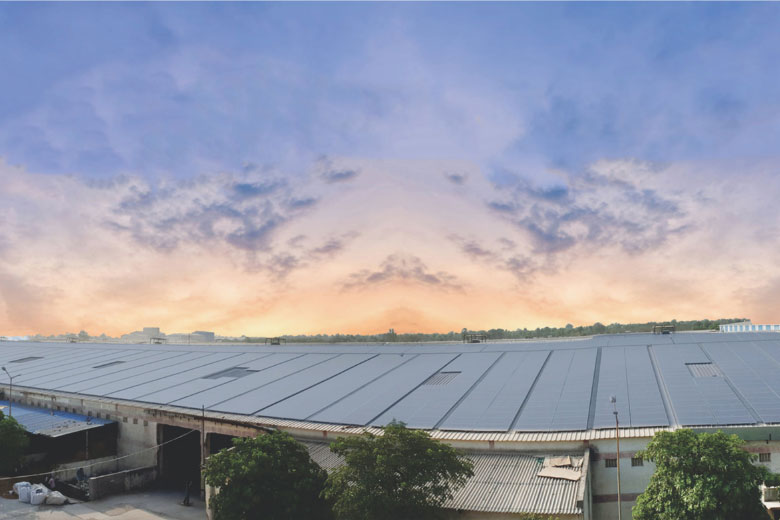From Rank 4 in 2016 to India's #1 Solar Developer in 2020: A look at Fourth Partner Energy’s growth trajectory and India’s Rooftop Solar Policy
Karan Chadha
May 2021

INDIA’s INITIATION TO ROOFTOP SOLAR
Distributed Solar a.k.a rooftop solar started in India about a decade ago with the initial impetus given by government schemes like the Nehru Solar Mission. The latest market estimates peg the industry at nearly 1,300–1,500 MW per year, making this a ₹5000 Crore industry, comprising 20–25% of the total annual solar installations on the country. Given the size and importance of this segment in order to achieve the country’s ambitious target of 175 GW renewable energy by 2022, (100 GW solar, out of which 40 GW is through rooftop installations) let us assess the key factors and trends for this segment.
ON-SITE OR ‘BEHIND-THE-METER’ SOLAR INSTALLATIONS
The nomenclature for rooftop solaris a misnomer – a better way to classify this segment is ‘behind the meter’ or ‘on-site’ projects. Over the last few years, as the price economics of solar has improved –apart from just idle roof space being utilised, we have executed a larger number of solar installations on land within the customer premises, floating solar on water bodies, on raised structures like carports and terraces. Customers realize the potential of using unutilized real estate within their plants and factories to produce cheaper and sustainable energy.
IMPORTANCE OF LONG-TERM, STABLE POLICY
India’s rooftop solar segment grew rapidly from 2015–2018 but has flatlined in the last couple of years. Undoubtedly, the global pandemic has dented the sentiment, like in all most other sectors but more specifically, prohibitive Net-metering policies by State distribution companies has slowed down the pace of growth. We fundamentally agree that there is a cost to usage of the grid as a storage mechanism and Discoms should be compensated fairly for the same to create win-win outcomes. However, clamping down on Net-metering is not the solution and such unilateral policymaking hurts all stakeholders, thereby making our industries less competitive in a global marketplace.
ROLE OF C&I (COMMERCIAL & INDUSTRIAL) SEGMENT IN ROOFTOP SOLAR
Among the different sectors, the major growth driver for the segment has been the C&I segment. Their share in rooftop installations has grown as private sector entities have mandated Sustainability targets and ESG compliance. The C&I segment is quality conscious, expects timely completion of their projects in a cost-effective manner and wants high maintenance standards. These are the key competencies that we at Fourth Partner Energy strive to improve on an everyday basis.
THE ‘OPEX’ MODEL – DEVELOPER’s ABILITY TO FINANCE A PROJECT
One of the key reasons behind 4PEL’s growth as a market-leader in distributed solar is our access to green finance. We are proud of our growing network on investors, financiers and lenders that include TPG, The RISE Fund, Chennai Angels, Infuse Ventures, CDC, Bank of America, SBI, HDFC, ICICI, RBL. IndusInd, Oiko Finance, Symbiotics and responsibility including others. This network has enabled us to extend ‘OPEX’ services to the customer, because of our ability to finance these projects. In simple terms, this model requires the client to only pay for per unit of electricity consumption – this model aligns the incentives of the developers and customers to maximize the energy output through quality construction and maintenance.
In recent years, the OPEX segment has grown from ~10% to nearly 30% of the total market. It is evident that an improvement in the ability of all developers to finance such projects will drive higher adoption. Ensuring insurance in case of the SME segment will also help accelerate rooftop solar adoption.
OUTLOOK ON ROOFTOP SOLAR IN INDIA
Looking ahead, we believe that distributed solar will continue to form a large part of our installed base on the back of improved technology, proven commercial model and increased focus of the corporate sector on decarbonisation and sustainability.
On the technology front, improved PV technology (higher capacity and efficiency modules) and the declining cost of battery storage will be key drivers for increased adoption. Already, we have seen that the Solar + Battery Storage is viable in cases where commercial tariff is high (>₹10/kWh) or where there is excessive dependence on Diesel or other fuel-based gensets. Solar + Battery storage could even reduce further, to achieve grid parity by FY24, thereby reducing the industry’s dependence on Net-metering policies.
FOURTH PARTNER ENERGY’s CUSTOMISED SOLAR SOLUTIONS
For us at Fourth Partner Energy, we believe that distributed solaris a customer service business. We are focused on ensuring quality installation, thorough maintenance and providing our customers the choice between various financial models and customised designs – to ultimately choose the solar solution that serves them best. Recently, we have also introduced BESS (Battery Energy Storage Solutions) and EV Charging Infrastructure to ensure a whole gamut of renewable energy solutions to the corporate sector, thereby accelerating India’s decarbonisation goals.